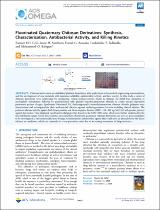 ResearchSpace
ResearchSpace
Fluorinated quaternary chitosan derivatives: Synthesis, characterization, antibacterial activity, and killing kinetics
JavaScript is disabled for your browser. Some features of this site may not work without it.
- ResearchSpace
- →
- Research Publications/Outputs
- →
- Journal Articles
- →
- View Item
| dc.contributor.author |
Cele, Zamani ED

|
|
| dc.contributor.author |
Somboro, AM

|
|
| dc.contributor.author |
Amoako, DG

|
|
| dc.contributor.author |
Ndlandla, Lindokuhle F

|
|
| dc.contributor.author |
Balogun, Mohammed O

|
|
| dc.date.accessioned | 2021-04-06T09:17:44Z | |
| dc.date.available | 2021-04-06T09:17:44Z | |
| dc.date.issued | 2020-11 | |
| dc.identifier.citation | Cele, Z.E., Somboro, A., Amoako, D., Ndlandla, L.F. & Balogun, M.O. 2020. Fluorinated quaternary chitosan derivatives: Synthesis, characterization, antibacterial activity, and killing kinetics. <i>ACS Omega, 5(46).</i> http://hdl.handle.net/10204/11947 | en_ZA |
| dc.identifier.issn | 2470-1343 | |
| dc.identifier.uri | https://pubs.acs.org/doi/10.1021/acsomega.0c01355 | |
| dc.identifier.uri | https://www.ncbi.nlm.nih.gov/pmc/articles/PMC7689678/ | |
| dc.identifier.uri | http://hdl.handle.net/10204/11947 | |
| dc.description.abstract | Chitosan has become an established platform biopolymer with applications in biomedical engineering, nanomedicine, and the development of new materials with improved solubility, antimicrobial activity, and low toxicity. In this study, a series of chitosan derivatives were synthesized by conjugating various perfluorocarbon chains to chitosan via Schiff base formation or nucleophilic substitution, followed by quaternization with glycidyl trimethylammonium chloride to confer non-pH-dependent permanent positive charges. Synthesized fluorinated N-(2-hydroxypropyl)-3-trimethylammonium chitosan chloride polymers were characterized and investigated for their antibacterial efficacies against multidrug-resistant bacteria including clinical isolates. The polymers showed activity against both Gram-positive and Gram-negative bacteria (MIC = 64–512 μg/mL) but with greater potency against the former. They displayed rapid bactericidal properties, based on the MBC/MIC ratio, which were further confirmed by the time-kill kinetic assays. Given the properties presented here, fluorinated quaternary chitosan derivatives can serve as great candidates to be investigated as environmentally more benign, nontherapeutic antimicrobial agents that could serve as alternatives to the heavy reliance on antibiotics, which are currently in a very precarious state due to increasing occurrence of drug resistance. | en_US |
| dc.format | Fulltext | en_US |
| dc.language.iso | en | en_US |
| dc.source | ACS Omega, 5(46) | en_US |
| dc.subject | Biopolymers | en_US |
| dc.subject | Chitosan | en_US |
| dc.subject | Kinetics | en_US |
| dc.title | Fluorinated quaternary chitosan derivatives: Synthesis, characterization, antibacterial activity, and killing kinetics | en_US |
| dc.type | Article | en_US |
| dc.description.pages | 29657-29666 | en_US |
| dc.description.note | This is an open access article published under an ACS AuthorChoice License, which permits copying and redistribution of the article or any adaptations for non-commercial purposes. | en_US |
| dc.description.cluster | Chemicals | en_US |
| dc.description.impactarea | Advanced Functional Materials | en_US |
| dc.identifier.apacitation | Cele, Z. E., Somboro, A., Amoako, D., Ndlandla, L. F., & Balogun, M. O. (2020). Fluorinated quaternary chitosan derivatives: Synthesis, characterization, antibacterial activity, and killing kinetics. <i>ACS Omega, 5(46)</i>, http://hdl.handle.net/10204/11947 | en_ZA |
| dc.identifier.chicagocitation | Cele, Zamani ED, AM Somboro, DG Amoako, Lindokuhle F Ndlandla, and Mohammed O Balogun "Fluorinated quaternary chitosan derivatives: Synthesis, characterization, antibacterial activity, and killing kinetics." <i>ACS Omega, 5(46)</i> (2020) http://hdl.handle.net/10204/11947 | en_ZA |
| dc.identifier.vancouvercitation | Cele ZE, Somboro A, Amoako D, Ndlandla LF, Balogun MO. Fluorinated quaternary chitosan derivatives: Synthesis, characterization, antibacterial activity, and killing kinetics. ACS Omega, 5(46). 2020; http://hdl.handle.net/10204/11947. | en_ZA |
| dc.identifier.ris | TY - Article AU - Cele, Zamani ED AU - Somboro, AM AU - Amoako, DG AU - Ndlandla, Lindokuhle F AU - Balogun, Mohammed O AB - Chitosan has become an established platform biopolymer with applications in biomedical engineering, nanomedicine, and the development of new materials with improved solubility, antimicrobial activity, and low toxicity. In this study, a series of chitosan derivatives were synthesized by conjugating various perfluorocarbon chains to chitosan via Schiff base formation or nucleophilic substitution, followed by quaternization with glycidyl trimethylammonium chloride to confer non-pH-dependent permanent positive charges. Synthesized fluorinated N-(2-hydroxypropyl)-3-trimethylammonium chitosan chloride polymers were characterized and investigated for their antibacterial efficacies against multidrug-resistant bacteria including clinical isolates. The polymers showed activity against both Gram-positive and Gram-negative bacteria (MIC = 64–512 μg/mL) but with greater potency against the former. They displayed rapid bactericidal properties, based on the MBC/MIC ratio, which were further confirmed by the time-kill kinetic assays. Given the properties presented here, fluorinated quaternary chitosan derivatives can serve as great candidates to be investigated as environmentally more benign, nontherapeutic antimicrobial agents that could serve as alternatives to the heavy reliance on antibiotics, which are currently in a very precarious state due to increasing occurrence of drug resistance. DA - 2020-11 DB - ResearchSpace DP - CSIR J1 - ACS Omega, 5(46) KW - Biopolymers KW - Chitosan KW - Kinetics LK - https://researchspace.csir.co.za PY - 2020 SM - 2470-1343 T1 - Fluorinated quaternary chitosan derivatives: Synthesis, characterization, antibacterial activity, and killing kinetics TI - Fluorinated quaternary chitosan derivatives: Synthesis, characterization, antibacterial activity, and killing kinetics UR - http://hdl.handle.net/10204/11947 ER - | en_ZA |
| dc.identifier.worklist | 24166 | en_US |





